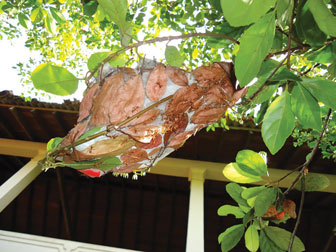|
Weaver ant:
The tiny arboreal nest weaver
by W.M.C.D. Wijekoon
 The Weaver ant is an elegant tiny insect, found in Indo-Malayan
region and Middle African areas of the world. They depute the
Genus-Oecophylla, one of the largest ant Family-Formicidae and commonly
named as Weaver ant. The well-known "Dimiya" (Oecophylla smaragdina) is
the species distributed in Asian and Australian region. The Weaver ant is an elegant tiny insect, found in Indo-Malayan
region and Middle African areas of the world. They depute the
Genus-Oecophylla, one of the largest ant Family-Formicidae and commonly
named as Weaver ant. The well-known "Dimiya" (Oecophylla smaragdina) is
the species distributed in Asian and Australian region.
They are obligatory arboreal and are known for their unique nest
building behaviour where workers construct nests by weaving together
leaves using larval silk. First they find leaves that are soft and easy
to bend. Then ants pull the two edges of the leaf together slowly.
More and more workers join and pull until the two edges are nearly
touching. Next, other worker ants carry larvae from the old nest and
gently squeeze them between their mandibles.
This causes the larvae to ooze a thin thread of silk. Such like nests
might be in size between smaller to larger. Colonies can be extremely
large consisting of more than a hundred nests spanning numerous trees
and contain more than half a million workers. Research findings revealed
that, the "Dimiya" more tend to build their nests in trees of Annona sp
(Vel atha), Calotropis gigantean (Wara), Acacia spp, Elaeocarpus
serratus (Veralu), Syzygium malaccensis (Jambu).
Indoor and outdoor habitats are also used for their nesting and milky
white webs can be seen in such nests.
Activity
Another fascinating behaviour of Weavers or "Dimiya" ant is that they
show territorial activity of inhabiting colony trees.
A recent study revealed that Anopholepis gracilipes / Ambalaya ant is
one of the territorial ants and when Weavers come close to them, they
tend to attack and ambush, although Weavers are larger ones and are very
aggressive.
Thus, in the environment you can see these two species inhabit in
colonies of separate trees.
 A large number of members in their colony consume a significant
amount of food, especially they feed on a variety of insects close to
their nest such as other ants, fireflies, beetles, bugs and all kind of
dead insects. As such, they play a significant ecological role in our
environment, hunting and killing of potentially harmful plant pests. A large number of members in their colony consume a significant
amount of food, especially they feed on a variety of insects close to
their nest such as other ants, fireflies, beetles, bugs and all kind of
dead insects. As such, they play a significant ecological role in our
environment, hunting and killing of potentially harmful plant pests.
Thus, they have traditionally been used as biological control agents
in Asian countries. One of the experimental results in South East Asia
has shown that, fruit trees harbouring Weaver ants produce higher
quality fruits, showing less leaf damage by herbivoures and require
fewer applications of synthetic pesticides.
However, that statement is debatable because other findings revealed
that living of Weaver ants on fruit trees may create negative effects
for the productivity.
Presence of ant colonies creates less performance by herbivores and
therefore reduces seed dispersal by insects and other animals including
pollinators.
In addition, Weaver ants have an indirect adverse effect on the
productivity of trees by protecting sap feeding insects such as scale
insects and leafhoppers from which they collect honeydew. Hence, by
protecting these insects from predators they increase their population
and increase the damage they cause to trees.
Some caterpillars of the Lycaenidae and Noctuidae butterfly families
secrete honeydew that attracts these ants to protect and survival of
them.
This is indeed an elegant scene of "Dimiya" ant, when they found a
caterpillar of Centaur oak blue butterfly, then carry the caterpillar
into Weaver's nest.
The scene has been studied by Douglas B. Ranasinghe, 2008, and is
noted as a very common thing. Another interesting feature is that
farmers in Vietnam and China also use Weaver ants as a form of weather
forecasting, as a change in the insects' behaviour can denote an
impending storm.
Inhabiting as a group is more significant for them for protection and
they have a strong chemical in their body "formic acid" which can be
used for their protection and protect the nest from predators. Although
ants do not have a stinger, they can inflict a painful bite which is
aggravated by irritating such chemical from their abdomen.
Significance of "Dimiya" ant gives ideas to promote the agricultural
practices among our farmers.
|

